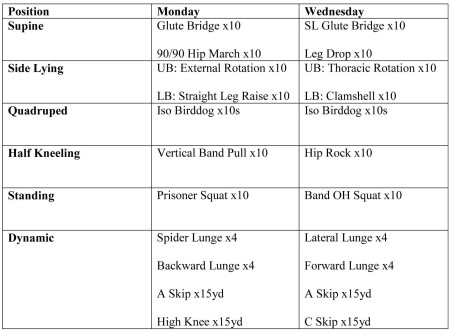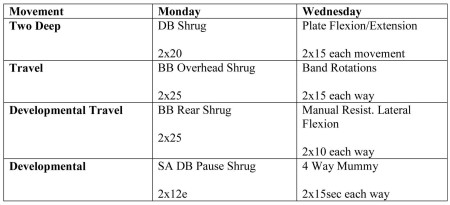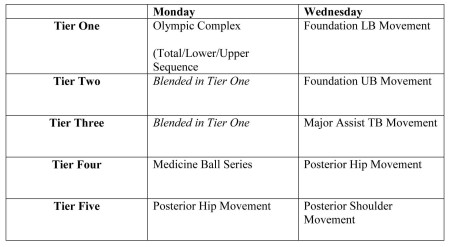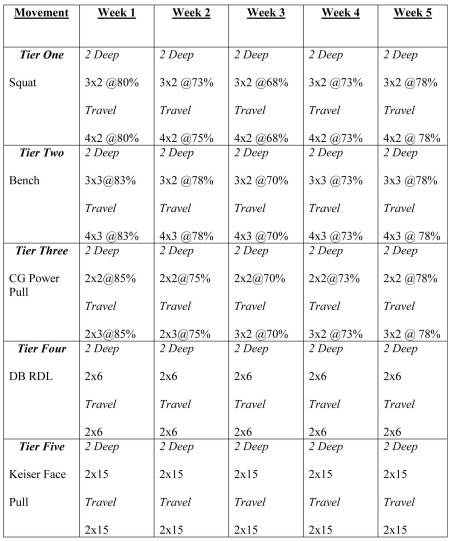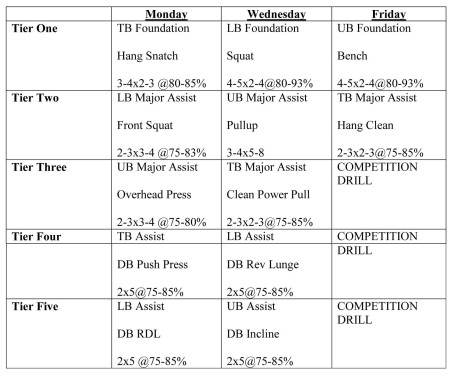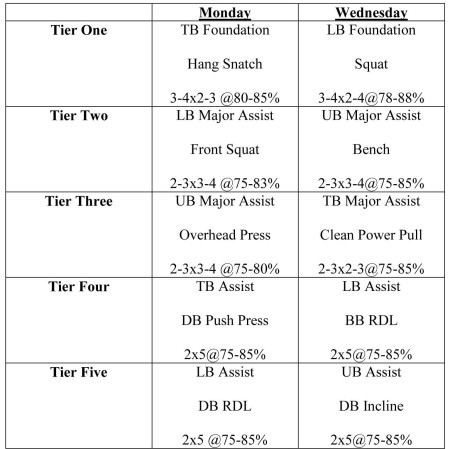Article CategoriesAFM Magazine
|
A Complete In-Season Training Programby: Jim McGuireAssistant Director of Strength and Conditioning, Merrimack College © More from this issue Our mission as a strength and conditioning department is to develop strong minds within strong bodies and prepare each athlete for the rigors and demands of college athletics. We have three goals we use to summarize the mission: Our team is divided into four training groups. Our two-deep group is comprised of all the players who will play 30+ snaps on a weekly basis. This includes all starters and anyone in a rotation. The travel group includes players who will play sparingly during a game, with the majority of their contributions coming on special teams or special situations. We also have a travel developmental group, made up of any newcomers to the program who will be getting significant playing time and be traveling on a consistent basis. These three groups will all train twice weekly, on Monday and Wednesday. Our fourth group is our developmental group, made up of the players who are not expected to get significant playing time or travel consistently. This group will train three times a week, on a Monday-Wednesday-Friday schedule. Each training session will include two components that all four groups will complete – a Ground Up Prep protocol and a Neck/Trap protocol. These two components are of utmost importance in maintaining durability and health throughout the season. We will perform Ground Up Prep as an entire team and then break off into different groups for our Neck/Trap work. The Ground Up Prep work serves two purposes: 1) to prepare the athletes for the training session, and 2) to ensure we are maintaining healthy, mobile bodies throughout the season. A sample week of Ground Up Prep work is included (Chart 1). We move from the ground to standing, implementing different mobility drills in basic fundamental positions and eventually progressing to dynamic flexibility drills and skips.
Chart 1: Ground Up Prep Schedule Our Neck/Trap work is another huge part of our program throughout the entire developmental year. We spend 10-15 minutes training this area every single time our athletes come in to train. We train the neck and traps using varying movements, resistances, tempos, and volumes to maximize the strength in the neck area and reduce the incidence/severity of head or neck injuries. A sample week of our Neck/Trap program is below (Chart 2).
Chart 2: Neck/Trap Program Schedule Monday serves as a total body session, aimed at restoring movement patterns and reloading from the game while preparing for the week ahead. Intensities and volumes will be low on Monday, the goal being to get the players moving through full ranges of motion and increasing blood flow. We combine our first three tiers into one movement, performing an Olympic weightlifting complex. The players get a range for their training load, typically between 55-65% of the total body movement’s 1 rep max. The range gives the players about 20 pounds of freedom to adjust weights within their sets based on their individual levels of readiness. The volumes adjust between 3-5 sets of 2-3 reps. After completing the complexes, we will move into a series of medicine ball throws. All of our throws will be performed standing and in a continuous fashion. We will perform 3-4 different variations in succession, totaling between 24-32 throws for 2-3 sets. We finish Monday with a low-load Posterior Chain movement such as Band Good Morning. Wednesday will be our lower body emphasis session. Everyone will perform a double leg squat variation as the tier one movement, with the majority of the group training back squat. Players with sports medicine restrictions will perform another squat variation - Front Squats, Safety Bar Squats, Goblet Squats, or Rear Foot Elevated Squats. Tier two will serve as our upper body movement, with the majority of the group performing the Bench Press. Modifications include Board Press, DB Bench Press, Single Arm DB Bench, or Loaded Pushups. We utilize Clean Power Pull as the tier three movement. Substitutions include Clean Pulls (shrugs), DB Snatch, or KB Swings. We will finish with a Posterior Complex, targeting the posterior hip and upper back. Our in-season periodization reflects block system principals, though it is not run as a traditional block system. We play a 10-game regular season schedule, so I split the season into two 5-week cycles. The first week of each cycle serves as an accumulation based week, aimed at refreshing our strength qualities to set up for the rest of the cycle. Training intensities will range from 80-88% during these weeks, with a total volume between 3-9 reps per movement in the first three tiers. We do not train at maximal intensities during the season. Our practice tempo is very high and requires a maximal output so we do not want to drain the body’s resources fully in the weight room. Training in this intensity range allows us to maintain and build strength while still allowing our players to practice at a high level. In certain situations, we allow some players to take a bonus set or hit a rep PR if they are capable. Following the accumulation week, we then run a four-week transmutation based block, aimed at maximizing our power output and ability to repeat explosive movements. The intensities range between 65-78%, with a total volume between 3-8 reps per movement in the first three tiers. We also utilize cluster sets during the transmutation block. Clusters sets are multiple rep sets with 10-15 seconds between reps. We may do a cluster double, where the player performs two reps and then rests 10 seconds before performing two more reps. This training method allows us to maximize our power output with each rep. Week six will again introduce accumulation based methods. We have had multiple instances of players hitting rep PRs in this week following the four-week transmutation block. Included is the two deep/travel groups movement rotation (Chart 3) and their five-week periodization cycle (Chart 4).
Chart 3: Two Deep/Travel Groups Movement Rotation
DEVELOPMENTAL GROUP AND TRAVEL DEVELOPMENTAL GROUP This is a time we will incorporate Strongman movements, obstacle courses, tug of wars, and other “outside the box” training methods. The winning team at the end of 10 weeks will be rewarded. The 10 week in-season program will serve as an extended accumulation influenced block, focusing on developing great technique in our movements and providing a foundation for the rest of their training careers. Intensities on the main lifts will be above 80% for the majority of the season, with total volumes varying between 6-15 reps. They will hit a reload week in the middle of the season, with intensities dropping to around 70% and volume falling to 6-9 reps on the main lifts. Chart 5 shows the Developmental Group Rotation and Load Ranges while Chart 6 shows the Developmental Travel Group Rotation with Load Ranges.
Chart 5: Developmental Group Rotation and Load Ranges
Chart 6: Developmental Travel Group Rotation with Load Ranges The implementation of a sound, well-planned in-season training program can have a major influence on the success of your team on the field. Training hard and staying strong can be the difference between missing two days or two weeks with an injury. Our in- season program has played an important role in keeping our team durable and healthy throughout the season and allowing our players to perform at their highest capabilities from August to November and beyond. |
|
| HOME |
MAGAZINE |
SUBSCRIBE | ONLINE COLUMNISTS | COACHING VIDEOS |
Copyright 2026, AmericanFootballMonthly.com
All Rights Reserved


